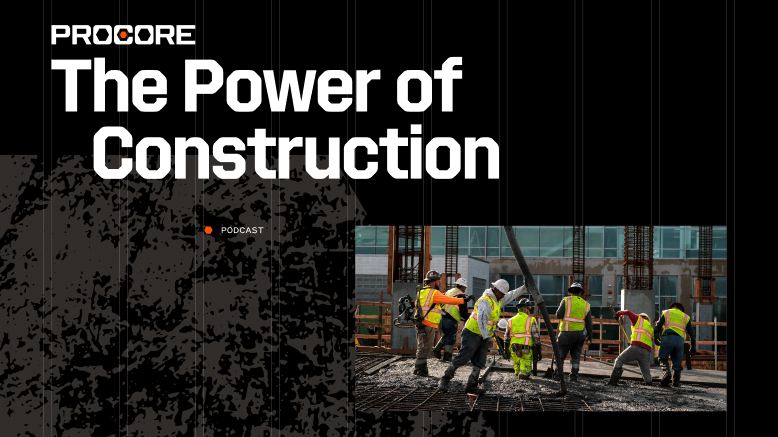— 17 min read
General Conditions in Construction: A Contractor’s Guide


Last Updated Jun 20, 2024

Michael Giusti
Michael Giusti is the Journalism Department Chairman and Director of Student Media at Loyola University New Orleans. He has worked as a journalist and writer for more than two decades, covering industries ranging from construction to insurance, finance, and logistics.

Mary Carroll-Coelho
Product Operations
12 articles
Mary Carroll-Coelho is a Product Operations Manager at Procore. A licensed Architect, Mary previously worked for KieranTimberlake, an architecture firm in Philadelphia, in construction and product operations at WeWork, and Director of Customer Success at Willow. She holds a Master of Architecture from the University of Pennsylvania. Outside of work, she volunteers as a mentor in the Spark program.
Last Updated Jun 20, 2024

In construction, general conditions refer to a variety of operations, procedures, and indirect costs that are not directly linked to construction, but are still essential for successfully executing the project. These conditions — which include project management, temporary site facilities, safety compliance, and waste removal, among many other things — are outlined in the construction contract and project specifications.
General contractors include the cost of general conditions in the estimates they provide to project owners when bidding or negotiating projects. For GCs, correctly estimating the cost of a project's general conditions — referred to as "soft costs" — can be the difference between profit and loss. However, it can be difficult to quantify the cost of general conditions, especially when there are unique or atypical project circumstances that are uncommon or site-specific.
In this article, we'll cover the major elements encompassed by general conditions and discuss how contractors estimate these costs.
Learn more: A contractor's ultimate guide to estimating
Table of contents
General conditions vs. general requirements
Though the terms are often confused (and sometimes used interchangeably), the difference between general requirements and general conditions is largely a question of what vs. how. In the general requirements, typically found in Division 1 of the specifications, the owner spells out exactly what the contractor needs to provide on the project. In the general conditions, the general contractor describes how they will fulfill each of the listed requirements — and how much they will cost.
For example, the general requirements may require the contractor to provide recycling containers for plastic and glass, in addition to garbage containers. It doesn't prescribe how many bins the contractor needs to provide, or who will collect them. In the general conditions, the contractor may include a line item of 50 recycling bins to be collected weekly by ABC Recycling Services, along with the cost.
Together, the general conditions and general requirements serve as "the rules of the game" — they outline the processes and procedures that are necessary for a successful project.
Division 1 of CSI MasterFormat lays out a variety of general requirements for construction, including information about project management, submittals, temporary facilities, project closeout, and more.
In common usage, many construction professionals use the term "general conditions” to encompass both conditions of the contract and requirements described in the project manual. In many cases, the general requirements listed in the project manual cover some of the same elements that could be outlined elsewhere in the contract.
For example, payment procedures, change orders, and safety protocols could be considered either general conditions of the contract, or general requirements for the project. As a result, construction professionals tend to lump these concepts together when discussing projects.
In other words, when project owners and contractors discuss general conditions, they are typically referring to the indirect cost of carrying out a construction project, which includes how the general conditions will fulfill the general requirements.
Explore data and trends for building materials prices.
Get the latest U.S. retail prices and view historical trends for common building materials.
What's included in general conditions?
General conditions cover a wide array of components, most of which are standard across many construction projects. Below is a list of some of the most common elements of general conditions as well as details on each component.
| Component | Description |
| Project management | Details on how communication, documentation, and reporting are handled, as well as the responsibilities of various stakeholders including the owner, contractors, and design team |
| Site management | Guidelines on how the site will be accessed and how waste will be removed from the site |
| Permits, licenses, and regulations | Information about who is required to obtain permits, licenses, and approvals, and the specific laws, codes, and regulations that are applicable to the project |
| Insurance and bonding requirements | The necessary insurance policies and bonds that stakeholders are required to have and the coverage limits |
| Change orders | The process for changing the scope of the contract, including how change orders are submitted, reviewed, and approved (or denied), and how the cost for change orders is handled |
| Payment terms | The payment schedule, how invoices are managed, and information about project retainage |
| Dispute resolution | The methods for resolving disputes, including the process for arbitration and litigation, if necessary |
| Project closeout and warranty | The requirements for substantial and final completion, punch lists, transfer of ownership, and any warranty provided by the contractor for their work |
Project management
The project management component of general conditions is often seen as the heartbeat of a construction project. The goal is to ensure transparent and efficient communication throughout the project to avoid any misunderstandings that could derail progress.
Some of the major aspects of the project management component of general conditions include:
- Roles and responsibilities: Clear definitions of the responsibilities and roles of all the stakeholders involved in the project, such as the project owner, general contractor, subcontractors, architects, and engineers.
- Communication protocols: Detailed guidelines on how communication should be handled among all parties involved in the project. This might outline which forms of communication are acceptable (e.g., email, in-person meetings), the expected frequency of communication, and who should be included in certain types of communication.
- Documentation procedures: Instructions on how project documentation should be created, handled, and stored. This can include methods for documenting project progress, and the required documentation for project closeout.
- Reporting requirements: Guidelines on what reports should be generated throughout the project, how often they should be created, and who they should be submitted to. Reports might include progress reports, financial reports, and safety reports.
- Meeting schedules: Details about when and where project meetings will occur, who should attend, and what should be discussed.
- Submittals process: Instructions on the submission, review, and approval process for submittals. Submittals may include shop drawings, product data, samples, and other related documents required for the work. This also includes who is responsible for making submittals, who reviews them, and the timeframe for review and response.
When creating project management guidelines, project owners must ensure that the instructions are clear and precise. Having well-defined communication channels and documentation processes not only keeps everyone on the same page but also allows for accountability in the case of any disagreements. Contractors must understand these guidelines clearly to ensure their activities are always aligned with project requirements and to minimize potential disputes.
Site management
The site management component spells out how the construction site will be accessed and managed. Understanding this part of the general conditions is crucial for contractors because it may affect their methods of operation and will certainly impact project costs.
Some of the major aspects of the site management component of general conditions include:
- Site access: Guidelines outlining how, when, and by whom the construction site can be accessed. This can include provisions for security measures, parking, and related logistics.
- Work hours: Detailed instructions about the allowable work hours on the construction site. This can include specifications about night-time work, weekend work, and any other restrictions.
- Site maintenance: Policies and procedures for the maintenance of the site, including daily clean-up, debris removal, and general upkeep.
- Waste removal: Procedures on how waste materials should be disposed of. This may also include the handling of hazardous materials, recycling programs, and any related regulations.
- Environmental compliance: Rules regarding compliance with environmental regulations. This can encompass erosion control measures, wildlife protection, noise level control, and other factors.
- Safety protocols: Guidelines for the safety measures that must be followed on the site. This may involve rules about Personal Protective Equipment (PPE), first aid facilities, fire prevention, and more.
- Temporary facilities: Specifications for the installation, maintenance, and removal of temporary facilities such as trailers, portable toilets, storage units, and water and power supply.
The project owner has the responsibility of defining site management conditions that are practical and in compliance with environmental regulations and local ordinances. On the other hand, contractors need to factor in the cost of adhering to these conditions into their bids. For example, restricted work hours or stringent safety requirements could affect labor costs.
Permits, licenses, and regulations
The permits, licenses, and regulations component details who will be responsible for obtaining the necessary permits and licenses to ensure that the construction work is legal and compliant with local building codes. The procedures for inspections and approvals may also be outlined in this section.
Some of the major aspects of the permits, licenses, and regulations component of general conditions include:
- Permit acquisition: Specifies who is responsible for obtaining necessary building permits, the procedures for doing so, and the related costs. This typically includes the permit application, fee payment, and follow-ups with the relevant authorities.
- Licenses: Details on required licenses for performing certain types of work, such as electrical or plumbing work. It identifies who will secure these licenses and any associated costs.
- Regulatory compliance: Information on the specific laws, regulations, and building codes the project must adhere to. This can range from local zoning laws to environmental regulations.
- Inspections and approvals: Procedures for scheduling, coordinating, and managing inspections by local authorities. This may also include the procedures for addressing any issues or violations identified during these inspections.
- Post-construction certificates: Information about who will obtain occupancy certificates or any other certificates required after the construction is completed. It outlines the procedure, responsibilities, and costs associated with securing these certificates.
Understanding this section is important for contractors, as the costs and time needed to secure permits and licenses should be accounted for in their bids and project timelines.
Insurance and bonding requirements
The insurance and bonding requirements component specifies the types of insurance policies and bonds that contractors must obtain as well as their respective coverage limits.
For example, the general conditions may lay out requirements for any of the following types of insurance or bonds:
- General liability insurance: Specifies the need for general liability insurance, which covers incidents like property damage and personal injury that could occur during the construction project. It details the coverage limits and who should provide this insurance.
- Workers' compensation insurance: Requires contractors to provide workers' compensation insurance to cover any injuries that employees may sustain while working on the project. It outlines the required coverage limits.
- Professional liability insurance: If applicable, the requirement for professional liability insurance (also known as errors and omissions insurance), which protects against losses incurred as a result of professional negligence.
- Performance bond: Specifies the requirement for a performance bond, a type of surety bond that guarantees the contractor will perform the work as outlined in the contract.
- Payment bond: If applicable, the requirement for a payment bond, which guarantees that all suppliers and subcontractors will be paid for their services.
- Builder's risk insurance: Details about any builder's risk insurance required, which provides coverage for damage to the construction project itself, such as from fires, storms, vandalism, and other risks.
These requirements ensure that there is financial coverage for potential risks that could arise during the project, such as property damage, personal injury, or failure to complete the project according to the contract terms.
Change orders
The change orders component of general conditions details the process for altering the original scope of the contract. It outlines how change orders can be submitted, how they will be approved or rejected, and how costs associated with changes will be handled.
General conditions related to change orders may include details like:
- Change order procedure: Outlines the steps required for submitting, approving, and implementing change orders, including any necessary documentation and time frames.
- Cost adjustment: Describes the method for determining and agreeing upon the costs associated with change orders, whether it involves additional work, less work, or alterations to the original scope.
- Work stoppage: Provides guidelines for situations where work may need to stop due to a pending change order.
- Documentation: Details the requirement for clear documentation of each change order, including the description of the change, the impact on the project timeline and cost, and signatures from all relevant parties confirming agreement to the changes.
Change orders are common in most construction projects, as owners may want modifications and unforeseen issues may arise during construction. It's important for both parties to understand and agree on this process to prevent disagreements and delays.
Payment terms
The payment terms component describes the payment schedule, how invoices will be managed, and details about retainage, if applicable. This part sets out when and how the contractor will be paid for their work.
The payment terms noted in the general conditions will include details about:
- Payment schedule: Details the frequency and conditions for payments, such as monthly or upon completion of specific milestones.
- Invoicing: Specifies the procedure for submitting invoices, including any necessary documentation, like progress reports, and the timeline for processing these invoices.
- Retainage: If applicable, provides details on the amount of money that will be withheld from each payment (typically a certain percentage) until the project is completed to ensure the quality of work.
- Final payment: Describes the conditions that must be met for the release of the final payment and any retainage, such as the completion of all work, resolution of any outstanding issues, and submission of final project documentation.
- Delayed payment consequences: Outlines the repercussions for late payments, which could include interest charges, work stoppages, or other penalties.
Understanding payment terms is important for contractors as it directly impacts their cash flow management. On the other hand, project owners need to ensure they can meet the payment schedule to maintain a good relationship with the contractor and ensure the smooth progress of the project.
Dispute resolution
The dispute resolution component of the general conditions sets out the processes for resolving disagreements that may arise during the project.
Here are some key aspects of the dispute resolution component of the general conditions:
- Negotiation: Specifies the initial process of resolving disagreements through direct discussions between the involved parties.
- Mediation: In the event negotiation fails, mediation may be the next step, which involves a neutral third party who assists in reaching a mutually agreed upon resolution.
- Arbitration: If mediation fails to resolve the dispute, the agreement may specify an arbitration process, where a neutral third party or panel makes a binding decision after hearing both sides.
- Litigation: In cases where the dispute can't be resolved through the previous steps, the process for taking the dispute to court may be outlined.
- Fees and expenses: Details who is responsible for covering the costs of each dispute resolution process, which may depend on the outcome of the process.
Disputes can cause significant delays and additional costs, so it's in the best interest of both parties to agree on a fair and efficient dispute resolution process from the outset.
Project closeout & warranty
The project closeout and warranty component stipulates the requirements for substantial and final completion, punch lists, transfer of ownership, and contractor's warranty for their work.
The general conditions will lay out information about several aspects of project closeout and warranty:
- Substantial and final completion: Describes the requirements and procedures for declaring the project substantially complete, and eventually, fully complete.
- Punch lists: Details how punch lists (lists of remaining work or corrections) will be handled and completed.
- Transfer of ownership: Outlines the process for officially handing over the project to the owner.
- Contractor's warranty: Specifies the duration and scope of the warranty period, during which the contractor is responsible for rectifying any defects that arise.
- Final documentation and inspections: Defines what documentation the contractor must provide upon completion, and the process for final inspections of the work.
For contractors, comprehending these guidelines not only ensures that they appropriately plan for the project's final steps but also lets them properly account for any potential warranty costs in their bid. The closeout process involves many details, such as handling punch lists and providing final documentation, which need to be precisely managed for successful project completion. Furthermore, being aware of the warranty period and its terms will help contractors maintain a good reputation and a strong relationship with the project owner.
On the other hand, project owners need to guarantee that there is a well-defined process for substantial and final completion, a clear transfer of ownership, and a satisfactory warranty period for the work completed. By defining these elements, project owners can safeguard the quality of the delivered work and ensure a smooth transition at the end of the project.
How contractors estimate general conditions
Estimating the cost of general conditions is an intricate process that requires a deep understanding of the project at hand and the potential variables that could influence these costs. Here's a typical approach that general contractors employ to construct an effective and detailed estimate:
1. Use standard general conditions as a baseline
Most contractors establish a standard set of general conditions that act as their baseline for every project. This baseline includes common elements like job site office expenses, costs for temporary utilities, and permit fees, among others. It is typically formulated based on previous projects and forms the initial foundation for the new project's estimate.
2. Reference the project manual
The project manual, which comprises the construction contract and project specifications, offers vital information about the project. It dictates the unique elements and constraints that can alter the cost of the general conditions. For instance, a project situated in a bustling urban environment may have more stringent noise and waste disposal regulations, which could require additional compliance measures — resulting in increased costs.
3. Incorporate project- or site-specific conditions
Each construction project is distinct and may carry specific requirements or circumstances that need to be integrated into the cost estimate. These can include:
- Location: A project located in a remote area may incur additional costs for transporting materials and crew accommodation.
- Weather conditions: Projects in regions with harsh weather conditions may require adjustments to the project timeline, which can impact costs such as the duration of temporary facility rentals.
- Site access: Limited or restricted access to the construction site could raise logistics costs and necessitate more frequent, smaller deliveries of materials.
4. Use historical job costing data
Contractors often rely on job costing data from past projects to inform their estimates. This historical data offers a realistic overview of the probable costs associated with various elements of the general conditions.
5. Formulate the final estimate
Once all the above factors are considered, the contractor combines these details to create a comprehensive estimate. This involves adding up the baseline costs, additional expenses derived from project-specific factors, and adjustments made based on the project manual and historical data. This total gives a reasonable estimate of the cost of general conditions for the project.
It's noteworthy, however, that this remains an estimate — the actual cost of general conditions can vary as the project moves forward and unexpected issues surface. As such, contractors and project owners should be prepared for potential fluctuations in these costs, typically including contingency funds in place to safeguard the project's financial feasibility.
How general conditions affect project success
General conditions hold significant weight in the successful execution of construction projects. They form the backbone of construction project management, covering a range of necessary processes and protocols. Both contractors and project owners should devote time to thoroughly understanding these elements as they lay the groundwork for project administration, setting clear expectations for roles, responsibilities, and procedures.
For contractors, accurately estimating the cost of general conditions can significantly impact project profitability. It's a detailed process that goes beyond applying a standard percentage to direct construction costs. Contractors need to consider the specific characteristics of each project, assess site and project variables, and make informed adjustments based on project specifications and historical data.
Project owners, on the other hand, need to understand general conditions to facilitate clear, open communication with their contractors. They should be aware of the potential cost implications of unique project or site requirements and understand the possible variables that could affect these costs.
Data and technology are key to managing and understanding general conditions effectively. Using project data, contractors can refine their cost estimation processes and make informed decisions. Technology can also enhance efficiency, from communication and document management to tracking project costs and progress. Integrating technology and data into construction management not only streamlines operations but also enhances transparency, aiding in dispute resolution and fostering stronger relationships among all stakeholders.
Overall, general conditions in construction provide a blueprint for project management, outlining the rules and requirements for a successful project. By understanding these conditions thoroughly, leveraging data, and embracing technology, contractors and project owners alike can ensure smooth project execution and, ultimately, successful project delivery.
Was this article helpful?
Thank you for your submission.
96%
4%
You voted that this article was . Was this a mistake? If so, change your vote
Scroll less, learn more about construction.
Subscribe to The Blueprint, Procore’s construction newsletter, to get content from industry experts delivered straight to your inbox.
By clicking this button, you agree to our Privacy Notice and Terms of Service.
Thank you!
You’re signed up to receive The Blueprint newsletter from Procore. You can unsubscribe at any time.
Categories:
Written by

Michael Giusti
Michael Giusti is the Journalism Department Chairman and Director of Student Media at Loyola University New Orleans. He has worked as a journalist and writer for more than two decades, covering industries ranging from construction to insurance, finance, and logistics.
View profile
Mary Carroll-Coelho
Product Operations
12 articles
Mary Carroll-Coelho is a Product Operations Manager at Procore. A licensed Architect, Mary previously worked for KieranTimberlake, an architecture firm in Philadelphia, in construction and product operations at WeWork, and Director of Customer Success at Willow. She holds a Master of Architecture from the University of Pennsylvania. Outside of work, she volunteers as a mentor in the Spark program.
View profileExplore more helpful resources

How Close Are We to Bridging the Design-Build Divide?
For decades, construction decisions have often been made based on gut instinct. But what if the real barrier to transformation isn’t technology—it’s the divide between design and construction? In episode...

What Happens When Data Drives the Business?
Construction has long been seen as a low-margin industry. But what if the real problem isn’t the margins—it’s how decisions get made? In episode 17 of The Power of Construction,...

Preconstruction Partnerships: How Safety Pros Can Collaborate with Estimating & Proposal Teams
Construction leaders and safety professionals are developing a strong understanding of how safety programs positively impact project outcomes. When safety is woven into every aspect of operations from pre-construction to...

Estimate vs. Budget: Tools to Guide Construction Financial Planning
Whether building a residential home, a commercial complex or a large-scale infrastructure development, understanding and managing costs is key to completing a project on time and within financial limits. Effective...
Free Tools
Calculators
Use our calculators to estimate the cost of construction materials for your next project.
Templates
Find a template to help you with your construction project tasks.
Material Price Tracker
Get the latest U.S. retail prices and view historical trends for common building materials.
Glossary
Explore key terms and phrases used in the industry.
